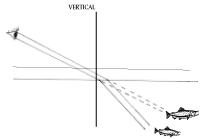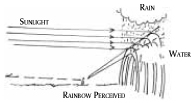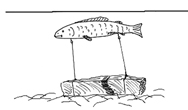Alaska Science Camps, Fairs & Experiments
ANKN is a resource for compiling and exchanging information
related to Alaska Native knowledge systems and ways of knowing. We
are pleased to create and distribute a variety of publications
that assist Native people, government agencies,
educators and the general public in gaining access to the knowledge
base that Alaska Natives have acquired through cumulative experience
over millennia.
TO ORDER THIS PUBLICATION:
Contact the ANKN
offices at 907-474-1902 or email uaf-cxcs@alaska.edu. Spearing Fish and
 the
Refraction the
Refraction
of Light
For many centuries Native people of Alaska
have lived from the abundant supplies of fish, those that remain
locally and those that migrate.
There have been a variety of ways of catching fish:
- Nets and dipnets
- Fishtraps
- Spearing
- Hooks/lures
Day to day, a family's survival depended on the ability to catch
fish.
In our area, we spear whitefish in the fall when ice is running in
the river. We go out in boats at night. For lighting, we put a
Coleman lamp in a five-gallon can that has been opened on one side.
The five gallon can protects the eyes of the fisherman from the
bright light, and reflects more light onto the river. From the front
of the boat, we spear whitefish.
 While
the river is still running ice in the fall, we also chop a wide hole
in the shore ice and spear whitefish through the hole. While
the river is still running ice in the fall, we also chop a wide hole
in the shore ice and spear whitefish through the hole.
Traditionally this was an important source of fish, as fish stored
at this time of year can be frozen and kept all winter. Nowadays
people can catch fish at any time and put them in the freezer.
Spearing from a boat while ice is running isn't as important now, but
it was and is an exciting adventure.
We also spear pike as they migrate between lakes in the spring.
They are camouflaged quite well against the dark creek bottom, and
are almost impossible to see as they swim in the creeks.

To gain an advantage, we peel spruce poles, lash them together,
and sink them with rocks. The poles are crosswise on the creek
bottom. When the fish swim with or against the current, they show up
clearly as they swim over the light colored poles. A white sheet or
cloth held on the bottom by rocks serves the same purpose. However,
if you spear too many holes in your mom's sheets, she will not be too
happy. Wooden poles are better in that regard.
Years ago, before nylon nets were available, upriver people
speared salmon from canoes. If king salmon are speared in the right
place, just behind the brain, they quiver and die easily. If they are
speared in the wrong place, the fisherman is in for a wild ride in
his canoe!
The challenge
It is exciting to spear fish, but our first efforts are usually
frustrating. There is a science principle that must be understood
before we can successfully spear fish. We see the fish, aim the spear
well, and miss, again and again. Sometimes they are too fast for us,
but other times, it seems that we are being tricked. The oldtimers
understand the science principle quite well. That is why the older
people can catch more fish than younger people even though the
younger people are quicker and have better eyes.
Understanding Refraction
When light passes through air, it travels in a straight line.
However, when light passes from the air to the water, or water to the
air, it is bent, or refracted. When light passes
through any two substances of different densities, the light changes
speed and is bent.
We think we see exactly where the fish is. Actually, the fish is
lower than we perceive. It appears closer to the surface than
it actually is. If you put the tip of your spear in the water, it
will seem bent.
The secret of spearing fish is to know how much below the image to
aim the spear. The fish isn't where you think it is!
The greater the angle (from the vertical) the fish is viewed from,
the more the light is bent. Spearing from directly above, the fish
will appear to be in the same place, but will appear bigger and
closer to the surface than it really is.

Do you think eagles and other birds of prey that catch fish need
to understand this science principle too? They must miss a few meals
until they learn this science lesson.
Other applications
When sunlight passes through air, and then passes through a cloud
or rain, we see a rainbow as the light is refracted and reflected
within the raindrops.
White light is separated into the individual colors shown in the
rainbow. (Look up Snell's Law for more information.)

 When our
eyes don't focus properly, we wear glasses that also refract the
light, bending it in exactly the right way so we can see clearly. When our
eyes don't focus properly, we wear glasses that also refract the
light, bending it in exactly the right way so we can see clearly.
Can you think of other applications of this science principle?
Experiment
Make a long blunt spear. Hang a wooden fish (about 18")
in the air
and practice spearing it until you get  fairly
accurate. Poke at the fish, do not throw the spear. If you hang it by
two strings it won't spin as much. fairly
accurate. Poke at the fish, do not throw the spear. If you hang it by
two strings it won't spin as much.
 With
that same spear, go to a clear creek, lake or river, and put the tip
of the spear in the water. Does the part of the spear that is in the
water seem to bend? Attach a target to a string (perhaps the same
wooden fish). Attach the string to a weight and sink it so the target
is 6" beneath the surface. Practice spearing the fish. How much below
do you have to aim? Does this change with the depth of the target?
Experiment at different angles, above the target and at a short or
long distance. Imagine that if you miss, you will have to skip your
next meal. With
that same spear, go to a clear creek, lake or river, and put the tip
of the spear in the water. Does the part of the spear that is in the
water seem to bend? Attach a target to a string (perhaps the same
wooden fish). Attach the string to a weight and sink it so the target
is 6" beneath the surface. Practice spearing the fish. How much below
do you have to aim? Does this change with the depth of the target?
Experiment at different angles, above the target and at a short or
long distance. Imagine that if you miss, you will have to skip your
next meal.
Try the same experiment with blunt spears of different weights and
lengths. Which is best for you?
If it is winter, you can still do this experiment with a long
washtub. Suspend one fish target over the tub, and sink one in the
water. From different distances, test your skill, eye and estimation
of refraction.
In the preceding experiments, what percentage of hits can you make
for the fish out of the water? For the fish in the water? Which
target is easier to hit?
If you are practicing on a creek, river, or lake, do this
experiment on a sunny day, and on a cloudy day. Try it with the sun
at your back or in your face. Do it at dusk after the sun has gone
down, but before dark. Try the same experiment with different kinds
of light at night (flashlight, strong flashlight, Coleman lantern,
torch.) What differences do you notice? What conclusions can you draw
from this? What are the best conditions to spear fish? What are the
worst conditions? Do Polaroid sunglasses help?
Ask the oldtimers in your village what kinds of fish they used to
spear. What time of year did this occur?
What were the best conditions for this activity (night, day, calm
weather, etc.?) What were the best locations? Ask them how they
stored those fish. Is this activity still possible today? If
possible, try it. What kinds of spear heads were used in the recent
past? Were they store-bought or homemade? If they used homemade spear
heads, make one according to their directions. What kinds of spear
heads were used long ago?
Ask the oldtimers in your village where the fish are going and
where they are coming from when they were being hunted. Why are they
traveling in the river or creek? What is the advantage of spearing
over hooking?
Find what the Alaska Department of Fish & Game know
about the
fish in your area. Compare their knowledge with that of the local
Elders.
|